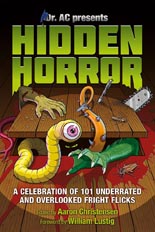
 While certainly well-intentioned, the idea behind Hidden Horror: A Celebration of 101 Underrated and Overlooked Fright Flicks is hardly new. For example, I immediately was reminded of a book that’s now 10 years old: Fangoria’s 101 Best Horror Movies You’ve Never Seen: A Celebration of the World’s Most Unheralded Fright Flicks. Hell, the titles are almost the same!
While certainly well-intentioned, the idea behind Hidden Horror: A Celebration of 101 Underrated and Overlooked Fright Flicks is hardly new. For example, I immediately was reminded of a book that’s now 10 years old: Fangoria’s 101 Best Horror Movies You’ve Never Seen: A Celebration of the World’s Most Unheralded Fright Flicks. Hell, the titles are almost the same!
Yet that’s not a complaint. At least not when so little overlap exists, when so many more movies have yet to get their due, and when the results are as finely polished as editor Aaron Christensen’s trade paperback is. Pay no mind to it being print-on-demand; this book exudes professionalism on all levels without sacrificing its pure indie spirit.
It’s also a good sign that I didn’t care that I have seen more than half of the 101 featured films and heard of all but two. No matter how deep your knowledge of the genre goes, Hidden Horror is a fun read above all else. While I suspect it will be used by burgeoning film buffs looking to expand their horizons in the years to come, it serves dual purpose as simply a fine collection of criticism and an opportunity to reconnect with titles that may have escaped your memory.
Following a foreword by no less an icon than Maniac director William Lustig, Christensen admits in his introduction that the movies covered in Hidden Horror may not truly be hidden at all. Degrees to which a film is “underrated” and/or “overlooked” is arguably as subjective as whether it is scary.
That’s why something like 1978’s notorious (or noxious, depending on your POV) as I Spit on Your Grave is included. Yes, the rape-revenge shocker has plenty of fans and caused plenty more furor in its time, but no, you’re not likely to have read about it quite like you will here, as BJ Coleangelo — a rape victim herself — defends the oft-maligned exploitation thriller as empowering cinema. Now that’s a refreshing take to read.
And so it goes with 100 other essays from writers, journalists and bloggers, each taking roughly three pages apiece to share and spill their love over a particular work, from the low-bar schlock of Horror of Party Beach to the high-minded artistry of Andrzej Zulawski’s Possession.
Only the spaghetti Western Django Kill … If You Live, Shoot! — no matter how surreal — strikes me as suspect for this lineup. Still, the piece on it is well-written; all of them are, which is more than a little surprising, given the sheer number of cooks in the kitchen.
Also worthy of a shout-out is John Pata for his terrific design work. What so DIY indie authors and publishers fail to recognize is that how a book looks is just as important as how it reads — and maybe even more so, since it creates that first impression upon flip-through. Bad design — or simply nonexistent design — can do harm to good work. Just look at Christensen’s previous collection, 2007’s Horror 101, the guts of which are as drab as to repel the eyeballs connected to interested minds.
Hidden Horror has no such problems; I’m not sure it has any problems, other than that soon after 300 pages, it comes to an end. —Rod Lott

That’s me in a nutshell, Rodd. Well writ, but highly suspect! Hey, at least my entry stands out! In any case, I’m very happy to merge paths with you again after so many years.
Best!
Paul
er, Rod. Sorry aboutt the exxtra “d”.
Forgiven! Paul, I hadn’t made the connection until your comment. But forgive me — and remind me: How do I know you again? My mind says “loyal subscriber to Hitch magazine,” but that feels like such a lifetime ago, I cannot be certain.
Yes. Loyal subscriber/correspondent.